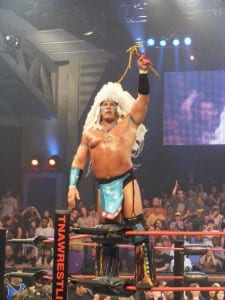In 2006, TNA felt the need to further live up to its reputation as the masters of pointless innovation. See, TNA was staging a “Fight for the Right” tournament, named after the Beastie Boys song, with the prize being a shot at the NWA title. While Dale Oliver had composed one of his famous and highly p(lagia)rized themes, TNA still needed a signature match to kick off the tournament, and a standard battle royal just wouldn’t do.
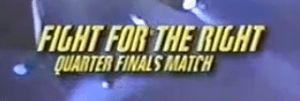
Thus, the land of the six-sided ring became home to the reverse battle royal.
Following in the footsteps of the reverse ladder match…
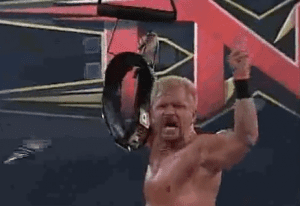
…and foreshadowing the reverse cage match…
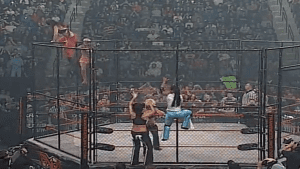
…TNA decided to turn the concept of the battle royal completely on its head. Or should that be “completely inside out”? Whatever the case, just like anything else that’s been turned on its head and inside out, the very concept of a battle royal suffered a cruel, gruesome death that should never have been displayed in public.
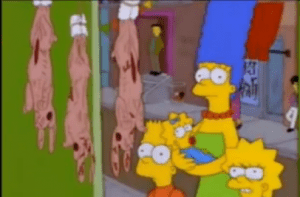
Unlike a regular battle royal, where you lost by going over the top rope to the outside, in the reverse battle royal, you won by going over the top rope to the inside. I was expecting eliminations to take place by taking both your opponent’s feet off the arena floor, or that victory could be achieved only by jumping out of the ring (like a cage match without the cage). At least with those options, there would have been no excuse to stretch the match out longer than ten seconds.
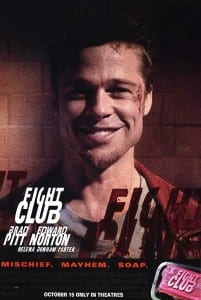
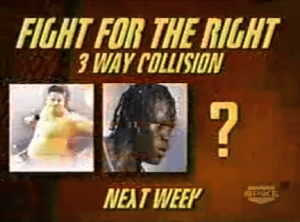 First rule of the Reverse Battle Royal: You do not watch the Reverse Battle Royal.
First rule of the Reverse Battle Royal: You do not watch the Reverse Battle Royal.Instead, 18 men started out on the outside of the ring and pretended to struggle to find their way into the squared, er, hexagonalized circle. Men who step into the ring, literally, every single match somehow forgot how to do so on this night and instead engaged in pointless brawling on the outside. Not since You Don’t Know Jack’s “$2 Million Question” had such a simple task been side-tracked in such a contrived, frustrating, and time-consuming way.
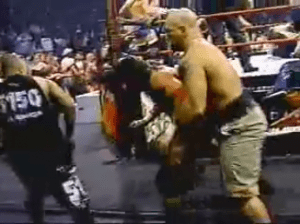
In the place of in-ring action and, you know, wrestling moves, we got lots of punches between opponents on the ring apron. It’s as if whoever designed this match thought that count outs were the most exciting finish in pro wrestling and decided to build a whole match around getting into the ring before the other guy.
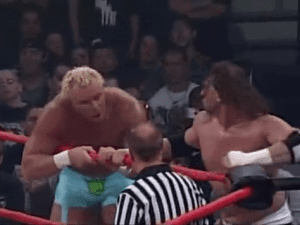
I could understand why it would be so important to keep your opponents from entering the ring if there were only one winner to this match, but in fact the first seven wrestlers to get into the ring were the “winners,” who advanced on to the next phase of the battle royal conducted under standard rules.
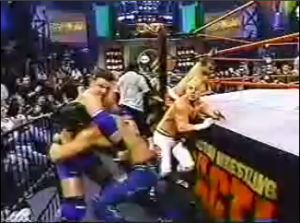
(For the record, yes, after hurling yourself into the ring, you then had to throw everyone else out of the ring. Then you won the battle royal… but only after you and the other co-winner wrestled a standard singles match in the third phase of the battle royal. Then you got a title shot… provided you could beat the winner of a six-man tournament featuring the other finalists. Here, just listen to that theme music again and let Don and Mike explain the rules).
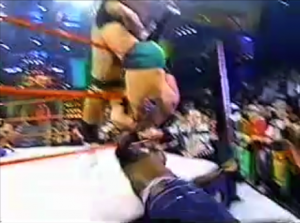
What I’m saying is, it realistically was not necessary (or even possible) to prevent everyone else from setting foot in the ring. With six sides to the ring and 18 men, that averaged out to three men on each side vying for entry. It made almost zero sense to waste your time brawling with your neighbors (while letting the other 15 men have a go at the ring) instead of just scrambling into the ring as fast as possible along with the one or two wrestlers nearby. That wouldn’t have made for a very entertaining match, but had that been TNA’s top priority, they wouldn’t have booked this match in the first place.
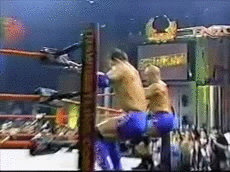
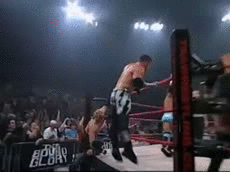
Perhaps I’m making this match seem much easier to win than it really was. After all, there was the added requirement of going over the top rope and into the ring in order to advance (get it? Because that’s the opposite of what you have to do in a regular battle royal!). However, whatever illusion existed of this being some impossible feat was shattered when Fatu was the first man to scale the ropes and set foot in the ring in one such match.
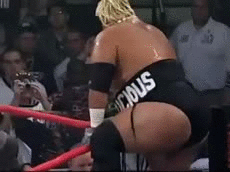
And yes, you read that right. There was more than one of these fiascos. TNA thought that their first reverse battle royal was such a rip-roaring success (it did win a Wrestling Observer Award: Worst Worked Match of 2006) that they decided to hold another one in 2007 at the biggest event of the year, Bound For Glory. Money in the Bank match, this was not (although the later “Feast or Fired” battle royal combined MITB’s guaranteed title shots in briefcases with Vince Russo’s fascination with objects on poles).
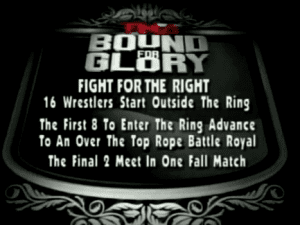
The 2007 edition featured 16 men, eight of whom would advance to Phase II. Highlights included lots of stalling and moments when wrestlers had clear paths to the ring, but instead just stood around looking to beat someone up…
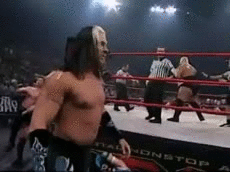
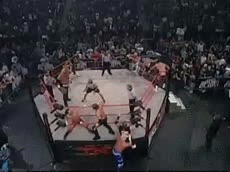
…Billy “Kip James” Gunn wearing God-knows-what…
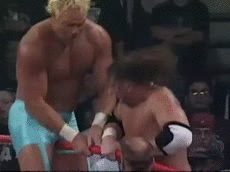
…both members of the Voodoo Kin Mafia failing to enter the ring after three entire minutes…
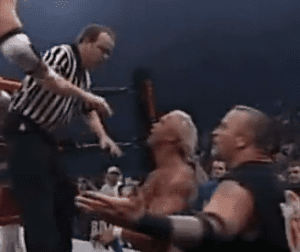
…and Chris Harris (the future Braden Walker) audibly shouting “Bullshit” when his former partner James Storm narrowly beat him into the ring. That’s what we were all thinking when this match began, Chris.
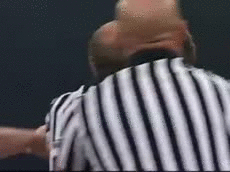
All joking aside, imagine how embarrassing it must have been, trying to advance a mere three feet ahead to enter the ring and then failing to do even that.
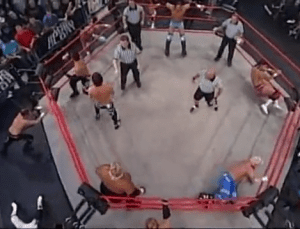
The final two wrestlers were Robert Roode and Eric Young, who at the time were engaged in a Wrestlecrap-inducted feud. Eric Young got the surprise pinfall to get on the fast track to a title shot… except that that year, all the eliminations did was determine the seeding in the tournament, which Young lost in the first round. Did this make the second Reverse Battle Royal even more convoluted than the first one?
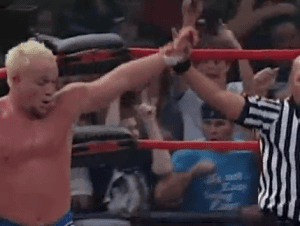
Perhaps, but TNA at least deserves credit for squeezing as much use out of this one match as they possibly could. About the only aspect of this match that they didn’t turn into a competition was getting dressed: imagine the whole locker room changing into their ring gear as fast as possible, with the first 18 men in tights gaining a berth in the battle royal. It’s a wonder Pat Patterson never thought of that when he invented the Royal Rumble.
Like the Native Americans of old who used every part of the buffalo they hunted, TNA did not let any bit of this match go to waste, whether it be the order of eliminations or even the entrances themselves, which less resourceful wrestling promotions squander by letting the wrestlers simply step into the ring unimpeded without so much as a fist-fight.
If only TNA had been so thoughtful when they got their hands on a real-live Tatanka (buffalo).
